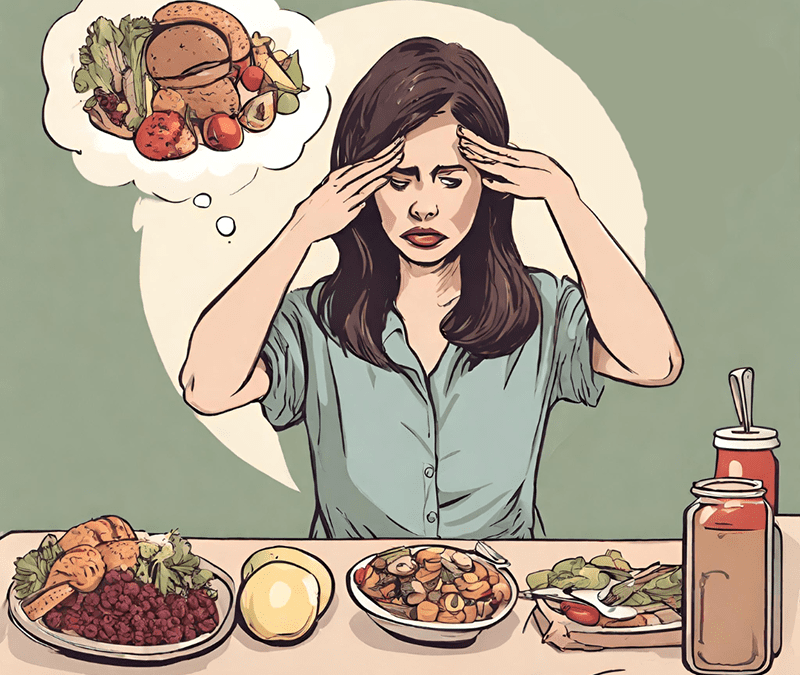Food
It’s the stuff that we love to hate and the stuff we hate to love. It can give us the energy to go about our day with a fierce focus or it can slowly drain us of every ounce of ambition. It can bring back fond memories of time with family or leave us in misery after we eat the dairy laden ice cream that we know our bodies won’t tolerate. It can torture us with guilt because it was a “forbidden” food or it can give us comfort when all seems lost. If it sounds complicated, that’s because it is. With grocery stores full of unhealthy hyper palatable processed foods and a society that insists that we be thin to be healthy it’s no wonder the masses are confused and diet culture has become so pervasive.
Diet culture revolves around our cultural myths on food, weight and general health.
It tends to focus on body “perfection” as an ideal and labels food as either “good” or “bad”. This is why most fad diets are based on food restriction. Even the new weight loss drugs restrict food by curbing your appetite, allowing you to eat less without even thinking about it. Don’t get me wrong, these strategies have their merit in that they can manage disease, they cut calories, they give you a hard solid plan that brings results when followed and many times, you can learn how certain foods affect your unique body. Can these strategies give you quick satisfying results if you stick to them? Absolutely. But do they teach you how to coexist peacefully with all of the foods and bring you life long health? Nope. Because what happens when and if the diet ends and you can suddenly eat all the foods again? Or what happens when you stop taking the weight loss drug and your former appetite sets back in?
So here’s my thought.
I propose that we work on our long term relationship with food. I mean, it’s not going anywhere so we might as well peacefully coexist.
This involves changing the way we think about food. What we know about food, how we look at food, how we feel about food, how we enjoy food or don’t enjoy food. Exploring our physical and emotional connections to food can give us insight into why we eat the foods we eat and how they affect our mind and body and the way our mind and body act and feel because of them.
So what if we decided that there were no “good foods” or “bad foods”? What if we could change our mindsets to be able to eat whatever we wanted because those choices are based on an educated and thoughtful intention every time? What if you could eat all the foods and still reach your health and wellness goals? Wouldn’t this be a much more peaceful way to live?
Strengthening our relationship with food and our bodies and learning to eat intuitively can be a key secret to counteract diet culture and achieve health that lasts as long as we do [1][2].
How do we do this you ask?
Become educated on the foods you eat (I’m actually creating a presentation on this now. So keep your eyes out for a live presentation Parker, CO people!)
⇒ Look at the nutritional information and the ingredients of your food. What are the ingredients? How many are there? Can you pronounce them all? How do they serve your body? Get educated. Take a course or hire a health coach.
No foods are off limits
⇒ This one is tricky but important. Polarizing food into “I can eat this” and “I can’t eat this” implies that there is a 0-10 vertical scale of good foods and bad which is just not the case. Instead, let’s get factual about it. Either it’s going to work in a positive way to help your body function at its best or it’s just going to taste really good and fulfill some other need, and while the former is preferred, the latter can be ok too. And this is not to say that nourishing food can’t be tasty. In fact, the fewer processed foods you eat, the tastier healthier foods can be.
Think about your food while you’re eating it (aka mindful eating)
⇒ How does it taste? What is the texture? Really pay attention to when you start to feel full. Also be aware that the sugar and fat in highly processed foods can increase our desire to continue consuming despite the fact that you’re full [3].
Keep a food and mood journal
⇒ That cheeseburger that you had yesterday may be affecting your mood or energy even as late as the next day. Eating healthier nutritious foods can help with mood swings, energy and mental focus. By journaling and keeping track of your food and the subsequent feelings in your body and mind, you can begin to see and feel the connection between the two, allowing you to make better choices depending on how you want to feel.
Know when you are actually hungry
⇒ The physical feeling of hunger and psychological hunger are very different and understanding the difference between the two is key. Physical hunger is when your body is in need of energy in the form of food. It comes over time and manifests itself through physical symptoms like hunger pangs, stomach noises, decreased energy, or difficulty concentrating. Psychological or hedonic hunger is driven by pleasure and has very little to do with what your body needs [4]. It comes on suddenly and can be attributed to anything from an emotionally rough day to merely passing by a bakery and smelling freshly baked bread.
Substitute emotional eating with another activity
⇒ Turning to food when you’re having a rough day is not uncommon. This is a vicious circle however in that the food that comforts your woes usually will not improve your psyche. So if you’re not physically hungry and just craving something that may not serve you later, try substituting it with something else. Go for a walk, write in a journal, call a friend or even just chew a piece of gum.
Don’t skip meals, especially breakfast
⇒ I’ve been hearing this one since I was a kid and there is some actual science to this one as well. Unless you’re doing intermittent fasting, skipping meals will not serve you in the end. While skipping meals may cut out some calories, some studies show that your lower blood sugar from a skipped meal can create some pretty serious cravings by the time that the next meal comes around, causing you to make some poor choices [5]. Starting with a breakfast that has a good balance of fat, protein and carbohydrates can have a positive effect on your food choices and cravings and all the way through to dinner.
Learn to accept your body as it is
⇒ Many times, concerns over food stem directly from a desire to change the shape or composition of your body, whether it’s to lose weight, gain muscle or lower cholesterol. Studies have shown that having a negative body image can lead to unhealthy attitudes towards food and eating [6]. Learning to accept your body in its current state, knowing that you are actively making steps to improve its health status, can effectively help with your choices when it comes to food.
Move your meat! (aka exercise)
⇒ Learning about the things that your body is physically capable of is so empowering. Get out and move! Once you start, the transfer effect can set in and your exercise behavior can start to positively influence your food choices [7].
Enjoy all the food!
⇒ Food is good. Yes there are some foods out there that offer little nutritional value, but that does not mean that you can never eat them. So when that piece of birthday cake comes your way, don’t say no because it is “forbidden”. If you truly desire it, grab a small piece, savor and truly taste every bite you choose to take, and then go on with your day knowing that your next food choice will benefit your body over your psyche’s sweet tooth.
Now this is definitely not an exhaustive list of the strategies that can be used to develop a positive relationship with food, but it’s a good start. And while I still occasionally find myself a little lost in diet culture, I have been using many of these strategies and I am finding peace with food. Because while fad diets and weight loss drugs like Ozempic and Monjauro can show quick and sometimes medically necessary results, they don’t teach you how to peacefully coexist with all the food. When that diet or weekly injection eventually ends, the presence of a wide array of tempting and yummy foods, from the nutritious to the super processed, will still be there and learning to navigate all of the choices without restriction is oh so important.
When it comes to long term weight management and good health, there is no easy and quick solution, no matter what anyone tries to sell you.
Like everything else in the world of health and wellness, sustainable change takes time and patience; one small habit at a time, one day at a time.
So try some of these strategies on and see how they fit because long term health that lasts as long as you do is most definitely within reach.
References
[1] Owens, B. A., Sabik, N. J., Tovar, A., Ward-Ritacco, C. L., & Oaks, B. M. (2023). Higher intuitive eating is associated with lower adiposity in midlife women. Eating behaviors, 50, 101796. https://doi.org/10.1016/j.eatbeh.2023.101796
[2] Babbott, K. M., Cavadino, A., Brenton-Peters, J., Consedine, N. S., & Roberts, M. (2023). Outcomes of intuitive eating interventions: a systematic review and meta-analysis. Eating disorders, 31(1), 33–63. https://doi.org/10.1080/10640266.2022.2030124
[3] Greenway, F. Physiological adaptations to weight loss and factors favouring weight regain. Int J Obes 39, 1188–1196 (2015). https://doi.org/10.1038/ijo.2015.59
[4] Lowe, M. R., & Butryn, M. L. (2007). Hedonic hunger: a new dimension of appetite?. Physiology & behavior, 91(4), 432–439. https://doi.org/10.1016/j.physbeh.2007.04.006
[5] Zeballos, E., & Todd, J. E. (2020). The effects of skipping a meal on daily energy intake and diet quality. Public health nutrition, 23(18), 3346–3355. https://doi.org/10.1017/S1368980020000683
[6] Adrienne S. Juarascio , Julie Perone & C. Alix Timko [email protected] (2011) Moderators of the Relationship Between Body Image Dissatisfaction and Disordered Eating, Eating Disorders, 19:4, 346-354, DOI: 10.1080/10640266.2011.584811
[7] Wasantha P. Jayawardene , Mohammad R. Torabi & David K. Lohrmann (2016) Exercise in Young Adulthood with Simultaneous and Future Changes in Fruit and Vegetable Intake, Journal of the American College of Nutrition, 35:1, 59-67, DOI: 10.1080/07315724.2015.1022268

